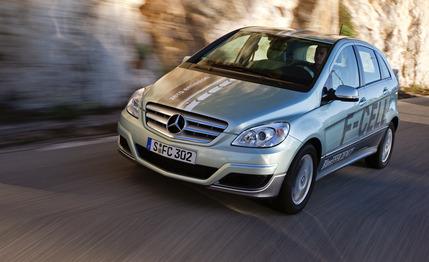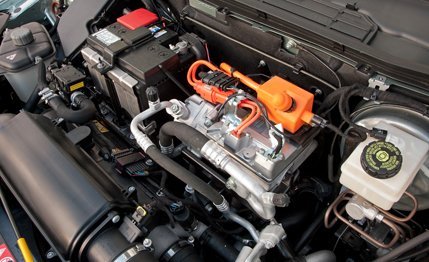
 Instrumented Test
Instrumented Test


If you want a hydrogen-fuel-cell car in this country, your options are limited and limiting. Honda was first to market with its FCX Clarity, and Mercedes-Benz has now followed with the B-class–based F-Cell. To take either one home, that home has to be located in Southern California, because that’s essentially the only place a limited fueling infrastructure exists. And you can only lease these rolling test beds from their manufacturers—Mercedes will let SoCal residents have an F-Cell for two years at a cost of $849 per month, which includes fuel, maintenance, collision insurance, and periodic chats with company researchers. In other words, you have to really want to adopt early.
The F-Cell is the only version of the B-class that has ever been offered in the U.S. It’s based on the previous-generation car—the new version just launched in Europe—and carries its hydrogen fuel cell in a sandwich-construction floor. This design, used on past A- and B-class models, was intended from the start to accommodate alternative-powertrain guts. (In conventionally powered models, the space would swallow the engine in front-end collisions.) During our brief first drive of the H-powered vanlet, it exhibited dynamics much like other B-class models we’ve experienced, and it seemed promising overall. So it’s like a normal car, but can it replace a normal car, even if just for those living in one very specific (and nonrepresentative) part of the U.S.?
Slow and Boring and Amazingly Normal
A thorough explanation of how fuel cells generate electricity from compressed hydrogen while emitting only water vapor can be found in our previous first-drive story. The electricity generated by this B-class’s fuel cell is sent to a 1.4-kWh lithium-ion battery that powers a 134-hp electric motor. The powertrain’s instant-on 214 lb-ft of torque does a decent job of moving the 3786-pound F-Cell along. But with 60 mph coming in 9.8 seconds, or a little more than half a second slower than the lighter FCX Clarity, the F-Cell is hardly quick. It does, however, beat many other green machines—including the Honda Insight and Toyota Prius hybrids, as well as the natural-gas-powered Honda Civic—to 60.


The F-Cell’s regenerative brakes are more than capable. A 174-foot stop from 70 mph bests that of the Prius and all the aforementioned Hondas by up to a car length. The electric motor switches to regen and starts scrubbing speed immediately when easing off the accelerator, which takes some acclimation to achieve smooth operation. Once mastered, you begin to plan ahead, saving the actual brake pedal for emergency stops only.
Around town, knowing the F-Cell is fueled purely by hydrogen and not a dead brontosaurus or the local power grid gives a creeping (and slightly creepy) sense of smug enjoyment to the driving experience—at least you’re feeling something, though, because driving the F-Cell is about as stimulating as listening to someone recite passages from the Yellow Pages. Utterly lifeless (though precise) steering and a gooey ride do everything they can to dissuade the F-Cell driver from exploring the car’s limits. Those limits are surprisingly high, thanks to the low center of gravity afforded by the in-floor battery pack; it pulls 0.84 g around the skidpad, not only kicking the enviro butts of most hybrids but also shaming CO2 spewers like the Chevrolet Cruze and Mazda 3 i Touring Skyactiv, both of which muster only 0.81 g.
Throughout the experience, the F-Cell exhibits the aural and visceral character of conventional electric cars. Which is to say none, other than a barely audible (yet satisfyingly futuristic-sounding) whir on full tilt. That said, we far prefer the F-Cell’s relative silence to some of the sounds emitted by other fuel-cell vehicles we’ve driven, ranging from the tickety-tick-tick-tickety noises of the first generation of Chevrolet Equinox–based fuel cells to the stepping-on-a-cat compressor whine that technical editor Aaron Robinson observed at the helm of the FCX Clarity.